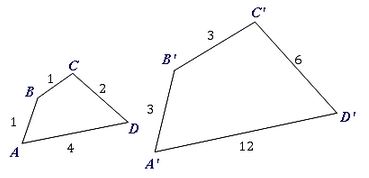Similar figures
Two shapes, or figures, are said to be similar if they are the same shape but different sizes. Similar shapes are either enlargements or reductions of one another.
Enlargements
A shape is considered an enlargement of another if one shape has side lengths that are all increased by the same scale factor.
Example
Take a triangle with side lengths measuring $3$3 cm, $4$4 cm and $5$5 cm. If each side is multiplied by the same factor, say $2$2, the new resulting triangle will have side lengths measuring $6$6 cm, $8$8 cm and $10$10 cm. The resulting shape is larger.
Reductions
A shape is considered a reduction of another if one shape has side lengths that are all decreased by the same scale factor.
Consider the reverse of the above example: a triangle with side lengths measuring $6$6 cm, $8$8 cm and $10$10 cm has each side multiplied by a factor of $\frac{1}{2}$12. The new resulting triangle will have side lengths measuring $3$3 cm, $4$4 cm and $5$5 cm. The resulting shape is smaller than the original.
The scale factor tells us by how much the object has been enlarged or reduced.
If the scale factor is greater than $1$1, the image is being made bigger than the original.
If the scale factor is smaller than $1$1, the image is being made smaller than the original.
Worked examples
Question 1
The shape $ABCD$ABCD has been transformed to $A'B'C'D'$A′B′C′D′.
a) Are the two shapes similar?

Think: To check if two shapes are similar each pair of corresponding sides must be in the same proportion. Identify corresponding sides, in some cases this might mean rotating or reflecting the shape, and compare the ratios of the matching sides.
Do:
| Side | Length | Side | Length | Scale factor |
|---|---|---|---|---|
| $AD$AD | $4$4 | $A'D'$A′D′ | $12$12 | $12\div4=3$12÷4=3 |
| $DC$DC | $2$2 | $D'C'$D′C′ | $6$6 | $6\div2=3$6÷2=3 |
| $CB$CB | $1$1 | $C'B'$C′B′ | $3$3 | $3\div1=3$3÷1=3 |
| $BA$BA | $1$1 | $B'A'$B′A′ | $3$3 | $3\div1=3$3÷1=3 |
Since all the ratios are the same, we can conclude that $ABCD$ABCD is similar to $A'B'C'D'$A′B′C′D′.
b) What is the scale factor to transform $ABCD$ABCD to $A'B'C'D'$A′B′C′D′?
Think: As we know the shapes are similar we can use the ratio of any two corresponding sides.
Do: The scale factor is $3$3. That is the shape $ABCD$ABCD has been enlarged by a factor of $3$3.
Practice questions
Question 1
The dimensions of the triangle shown are enlarged using a scale factor of $3.1$3.1.

What would be the new length of $AB$AB?
What would be the new length of $BC$BC?
What would be the new length of $CA$CA?
Question 2
Identify if quadrilateral $A'B'C'D'$A′B′C′D′ is a dilation of quadrilateral $ABCD$ABCD.
yes
Ano
B
Scale drawings and scale factors
Calculating scale
We can calculate the scale a photograph or map is using by looking at features or landmarks that have standard dimensions. For example if the pool in the following picture is a $25$25 m hotel pool, can you calculate the scale of the photo?

Swimming pool scale (Source: http://taxdollars.blog.ocregister.com/)
We know in real life the swimming pool is $25$25 m long. In the photo, the same size pool is only $50$50 cm. Therefore the photo is using a scale of $50$50 cm $:25$:25 m, which can also be expressed as $50$50 cm $:2500$:2500 cm. Simplifying this, we can say the photo is using a scale of $1:50$1:50.
Calculating distances
Using the same process in reverse, we can calculate distances on a photo or map if we know the scale.
What is the scale of the site map?

Scaled Site Plan (Source: http://www.arcadiawoods.com.au/media/siteplan-large.jpg)
We know the scale of the photo is $1:10000$1:10000. If the length of the site is $20$20 cm on the map, then its actual length is $20\times10000$20×10000 cm. Therefore its length is $200000$200000 cm or $2$2 km.
Practice questions
Question 3
A commercial plane measuring $66$66 metres long is to be represented on a scale model with a scale of $1:100$1:100. Find, in metres, the length of the plane in the scale model.
Give your answer in metres, correct to 2 decimal places.
